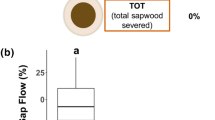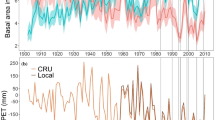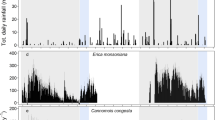Abstract
Key message
An experimental drought treatment, exacerbated by a natural drought event, compromised growth in Norway spruce, but more cavitation-resistant xylem was produced and no long-term growth reductions were observed.
Abstract
An experimental drought treatment in a mature Norway spruce forest that coincided with a rare drought event in southern Sweden in 1992, allowed us to study how such forests may respond to similar extreme events in the future. Immediately after the onset of the drought treatment, height and diameter growth decreased compared to control treatments. New xylem cells had smaller lumen und thicker walls, resulting in a more safety-orientated water transport system. The maximum growth and hydraulic system response of the 1990–1996 drought treatment coincided with the 1992 summer drought event. After the drought treatment ended, all measured traits recovered to control and irrigation treatment values after 3 years. While height and diameter growth recovered with delay, wood structure and hydraulic properties showed fast recovery. We conclude that a highly plastic response of the hydraulic system indicates a notable degree of resilience to droughts that are expected to become more common under climate change. Our results do not imply, however, that survival and productivity of Norway spruce plantations would not be compromised under drier conditions in the future, and they apply to site conditions equivalent to the studied system.



Similar content being viewed by others
References
Aitken SN, Yeaman S, Holliday JA, Wang T, Curtis-McLane S (2008) Adaptation, migration or extirpation: Climate change outcomes for tree populations. Evol Appl 1:95–111
Alavi G (2002) The impact of soil moisture on stem growth of spruce forest during a 22-year period. For Ecol Manage 166:17–33
Andreassen K, Solberg S, Tveito OE, Lystad SL (2006) Regional differences in climatic responses of Norway spruce (Picea abies L. Karst) growth in Norway. For Ecol Manage 222(1–2):211–221
Barnard DM, Meinzer FC, Lachenbruch B, McCulloh KA, Johnson MJ, Woodruff DR (2011) Climate-related trends in sapwood biophysical properties in two conifers: avoidance of hydraulic dysfunction through coordinated adjustments in xylem efficiency, safety and capacitance. Plant Cell Environ 34:643–654
Bates D, Maechler M, Bolker B (2012) lme4: Linear mixed-effects models using S4 classes R package version 0999999-0. http://cran.r-project.org/web/packages/lme4/index.html
Beguería, Vinte-Serano (2013) SPEI: calculation of the standardized precipitation-evapotranspiration index, Version 1.4. http://cran.rproject.org/web/packages/SPEI/index.html
Bergh J, Linder S, Lundmark T, Elfving B (1999) The effect of water and nutrient availability on the productivity of Norway spruce in northern and southern Sweden. For Ecol Manage 119:51–62
Bergholm J, Jansson P-E, Johansson U, Majdi H, Nilsson LO, Persson H, Rosengren-Brinck U, Wiklund K (1995) Air pollution, tree vitality and forest production—the Skogaby project general description of a field experiment with Norway spruce in south Sweden. In: Nilsson LO, Hiittl RF, Johansson UT, Mathy P (eds) Nutrient up- take and cycling in forest ecosystems ecosystem research report 21. Luxembourg, pp 69–87
Boden S, Schinker MG, Duncker P, Spiecker H (2012) Resolution abilities and measuring depth of high-frequency densitometry on wood samples. Measurement 45:1913–1921
Bréda N, Huc R, Granier A, Dreyer E (2006) Temperate forest trees and stands under severe drought: a review of ecophysiological responses, adaptation processes and long-term consequences. Ann For Sci 63:625–644
Bryukhanova M, Fonti P (2013) Xylem plasticity allows rapid hydraulic adjustment to annual climatic variability. Trees Struct Funct 27:485–496
Burke E, Brown S, Christidis N (2006) Modeling the recent evolution of global drought and projections for the twenty-first century with the Hadley Centre climate model. J Hydrometeorol 7:1113–1125
Chmielewski FM, Müller A, Bruns E (2004) Climate changes and trends in phenology of fruit trees and field crops in Germany, 1961–2000. Agric For Meteorol 121:69–78
Dalla-Salda G, Martinez-Meier AM, Cochard H, Rozenberg P (2009) Variation of wood density and hydraulic properties of Douglas-fir (Pseudotsuga menziesii (Mirb.)) clones related to a heat and drought wave in France. For Ecol Manage 257:182–189
Dalla-Salda G, Martinez-Meier AM, Cochard H, Rozenberg P (2011) Genetic variation of xylem hydraulic properties shows that wood density is involved in adaptation to drought in Douglas-fir (Pseudotsuga menziesii (Mirb.)). Ann For Sci 68:747–757
Denne MP (1988) Definition of latewood according to Mork (1928). IAWA J 10:59–62
DeSoto L, de la Cruz M, Fonti P (2011) Intra-annual pattern of tracheid size in the Mediterranean Juniperus thurifera as indicator for seasonal water stress. Can J For Res 41:1280–1294
Eilmann B, Zweifel R, Buchmann N, Fonti P, Rigling A (2009) Drought induced adaptation of the xylem in Pinus sylvestris and Quercus pubescens. Tree Physiol 29(8):1011–1020
Hacke UG, Sperry JS (2001) Functional and ecological xylem anatomy. Perspect Plant Ecol Evol Syst 4(2):97–115
Hacke UG, Sperry JS, Pockman WT, Davis SD, McCulloh KA (2001) Trends in wood density and structure are linked to prevention of xylem implosion by negative pressure. Oecologia 126:457–461
Hacke UG, Sperry JS, Pittermann J (2004) Analysis of circular bordered pit function II. Gymnosperm tracheids with torus-margo pit membranes. Am J Bot 91(3):386–400
Hamann A, Wang T, Spittlehouse DL, Murdock TQ (2013) A comprehensive, high-resolution database of historical and projected climate surfaces for western North America. Bull Am Meteorol Soc 94:1307–1309
Hanewinkel M, Cullmann DA, Schelhaas MJ, Nabuurs GJ, Zimmermann NE (2013) Climate change may cause severe loss in the economic value of European forest land. Nat Clim Chang 3:203–207
Hothorn T, Bretz F, Westfall P (2008) Simultaneous inference in general parametric models. Biom J 50:346–363
Jansson PE (1990) The Skogaby project. Project description. Swedish University of Agricultural Sciences and University of Lund, Uppsala
Jyske T, Hölttä T, Mäkinen H, Nöjd P, Lumme I, Spiecker H (2010) The effect of artificially induced drought on radial increment and wood properties of Norway spruce. Tree Physiol 30(1):103–115
Kolb KJ, Sperry JS (1999) Differences in drought adaptation between subspecies of sagebrush (Artemisia tridentata). Ecol 80:2373–2384
Lindberg N, Engtsson JB, Persson T (2002) Effects of experimental irrigation and drought on the composition and diversity of soil fauna in a coniferous stand. J Appl Ecol 39:924–936
Mäkinen H, Nöjd P, Mielikäinen K (2001) Climatic signal in annual growth variation in damaged and healthy stands of Norway spruce (Picea abies (L.) Karst.) in southern Finland. Trees Struct Funct 15:177–185
Martinez-Meier A, Sanchez L, Pastorino M, Gallo L, Rozenberg P (2008) What is hot in tree rings? The wood density of surviving Douglas-firs to the 2003 drought and heat wave. For Ecol Manage 256:837–843
Mayr S, Rothart B, Dämon B (2003) Hydraulic efficiency and safety of leader shoots and twigs in Norway spruce growing at the alpine timberline. J Exp Bot 54(392):2563–2568
Nilsson LO (1997) Manipulation of conventional forest management practices to increase forest growth—results from the Skogaby project. For Ecol Manage 91:53–60
Nilsson LO, Wiklund K (1992) Influence of nutrient and water stress on Norway spruce production in south Sweden—the role of air pollutants. Plant Soil 147:251–265
Park YI, Spiecker H (2005) Variations in the tree-ring structure of Norway spruce under contrasting climates. Dendrochronologia 23(2):93–104
Puhe J (2003) Growth and development of the root system of Norway spruce (Picea abies) in forest stands—a review. For Ecol Manage 175:253–273
R Development Core Team (2013) R: A language and environment for statistical computing. R Foundation for Statistical Computing, Vienna, Austria. http://www.R-project.org/
Rosner S, Klein A, Müller U, Karlsson B (2008) Tradeoffs between hydraulic and mechanical stress responses of mature Norway spruce trunk wood. Tree Physiol 28:1179–1188
Rozenberg P, Van Loo J, Hannrup B, Grabner M (2002) Clonal variation of wood density of cambium reaction to water deficit in Picea abies (L.) Karst. Ann For Sci 59:533–540
Schinker M, Hansen N, Spiecker H (2003) High-frequency densitometry—a new method for the rapid evaluation of wood density variations. IAWA J 24(3):231–239
Schlyter P, Stjernquist I, Bärring L, Jönsson AM, Nilsson C (2006) Assessment of the impacts of climate change and weather extremes on boreal forests in northern Europe, focusing on Norway spruce. Clim Res 31:75–84
Schmidt-Vogt H (1977) Die Fichte (Band 1)—Taxonomie, Verbreitung, Morphologie, Ökologie, Waldgesellschaften. Parey, Hamburg
Schutt P, Cowling EB (1985) Waldsterben, a general decline of forests in central-Europe—symptoms, development and possible causes. Plant Dis 69(7):548–558
Solberg S (2004) Summer drought: a driver for crown condition and mortality of Norway spruce in Norway. For Pathol 34(2):93–104
Spiecker H (2002) Silvicultural management in maintaining biodiversity and resistance of forests in Europe—temperate zone. J Environ Manage 67(1):55–65
Spiecker H, Schinker MG, Hansen J, Park YI, Ebing T, Döll W (2000) Cell structure in tree rings: novel methods for preparation and image analysis of large cross sections. IAWA J 21:361–373
Turtola A, Manninen AM, Rikala R, Kainulainen P (2003) Drought stress alters the concentration of wood terpenoids in scots pine and Norway spruce seedling. J Chem Ecol 29(9):1981–1995
Tyree MT, Zimmermann MH (2002) Xylem structure and the ascent of sap. Springer, Berlin
Tyree MT, Davis SD, Cochard H (1994) Biophysical perspectives of xylem evolution: is there a tradeoff of hydraulic efficiency for vulnerability to dysfunction? IAWA J 15:335–360
van der Maaten-Theunissen M, Kahle HP, van der Maaten E (2013) Drought sensitivity of Norway spruce is higher than that of silver fir along an altitudinal gradient in southwestern Germany. Ann For Sci 70(2):185–193
Wang T, Hamann A, Spittlehouse DL, Murdock TQ (2012) ClimateWNA—high-resolution spatial climate data for western North America. J Appl Meteorolog Climatol 51:16–29
Acknowledgments
The authors are grateful to the management of the Skogaby-project, Ulf Johansson and Thomas Binder for their support during the tree sampling. We thank Felix Baab and Clemens Koch for sample preparation. Comments by anonymous reviewers, Miriam Isaac-Renton and Marieke van der Maaten-Theunissen helped improve an earlier version of this manuscript.
Conflict of interest
The authors declare that they have no conflict of interest.
Author information
Authors and Affiliations
Corresponding author
Additional information
Communicated by A. Nardini.
Rights and permissions
About this article
Cite this article
Montwé, D., Spiecker, H. & Hamann, A. An experimentally controlled extreme drought in a Norway spruce forest reveals fast hydraulic response and subsequent recovery of growth rates. Trees 28, 891–900 (2014). https://doi.org/10.1007/s00468-014-1002-5
Received:
Revised:
Accepted:
Published:
Issue Date:
DOI: https://doi.org/10.1007/s00468-014-1002-5




